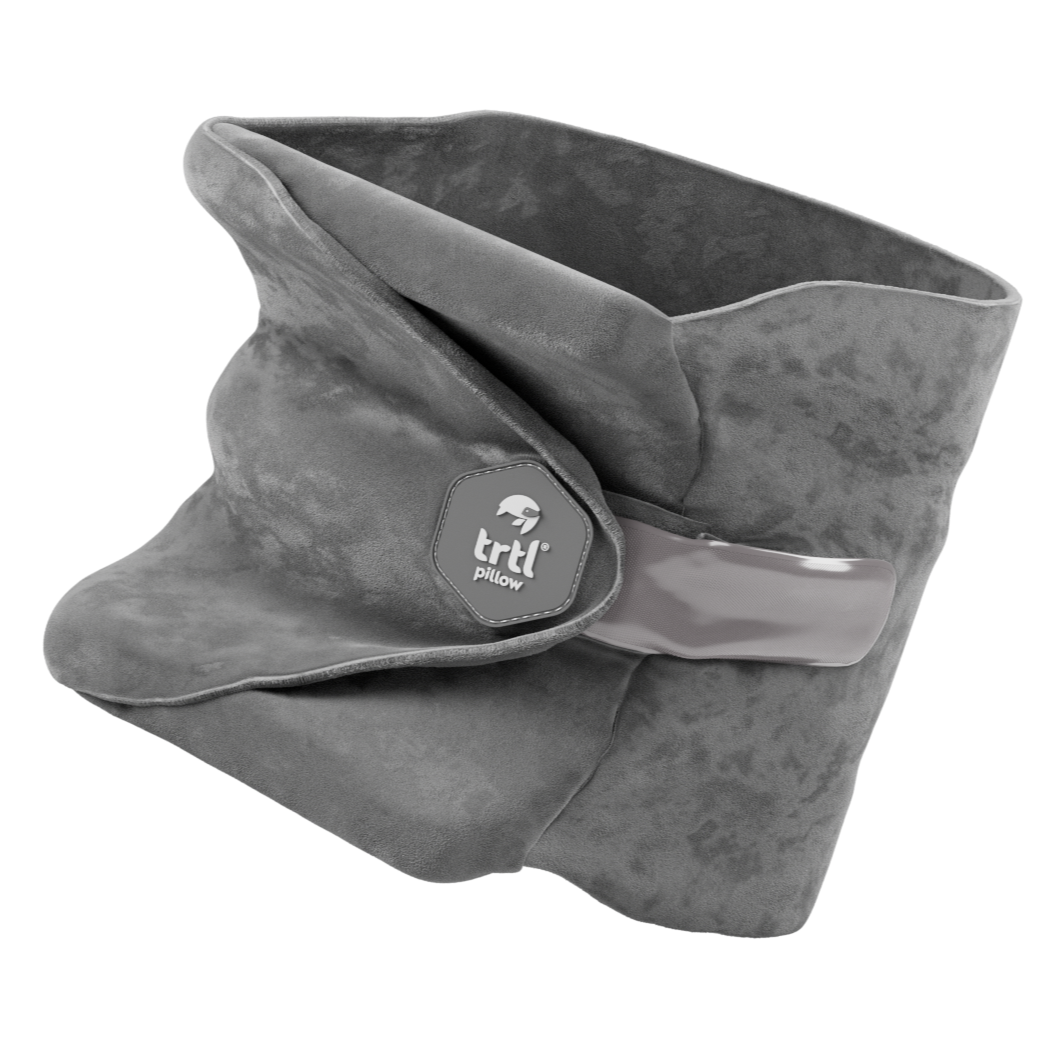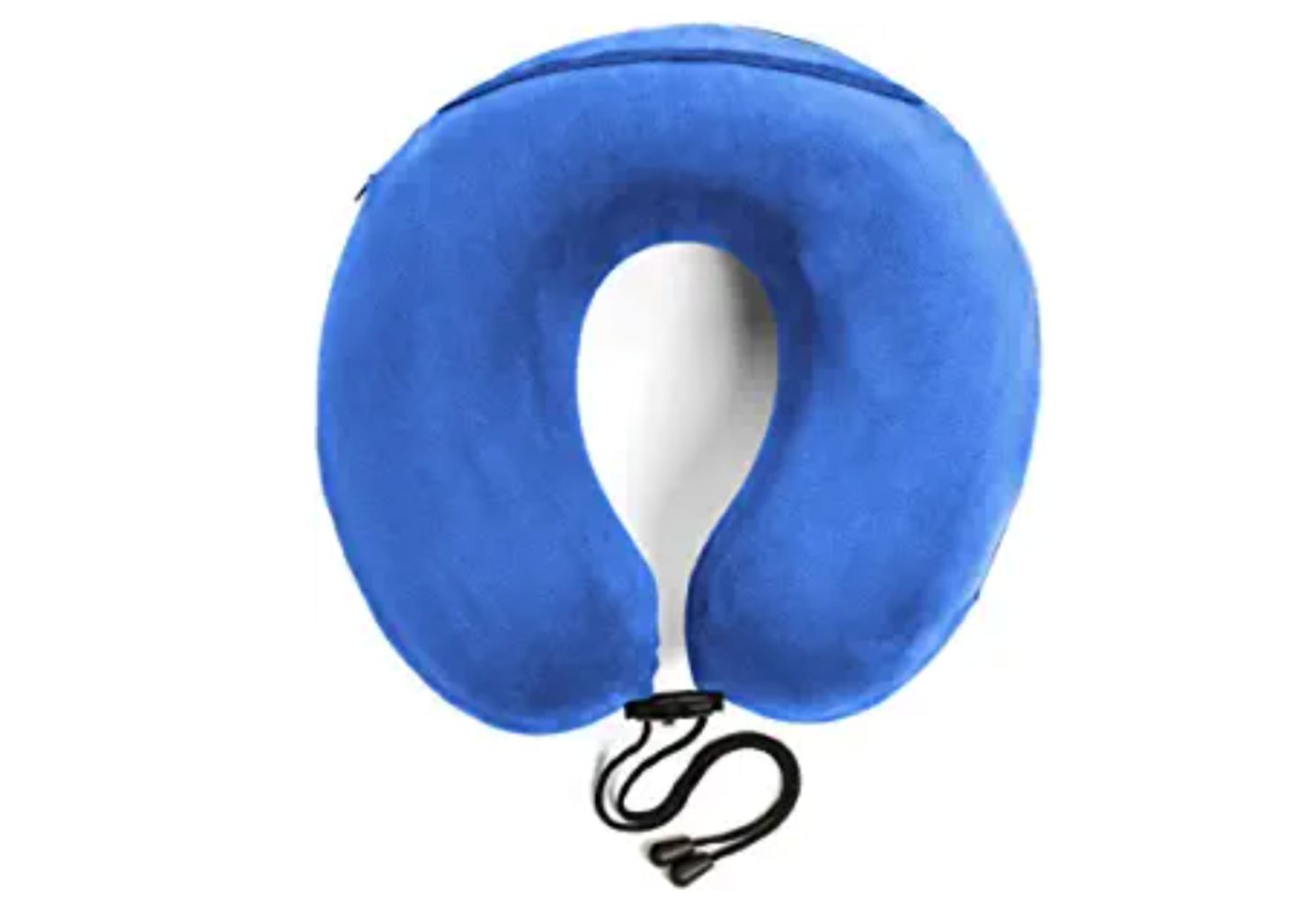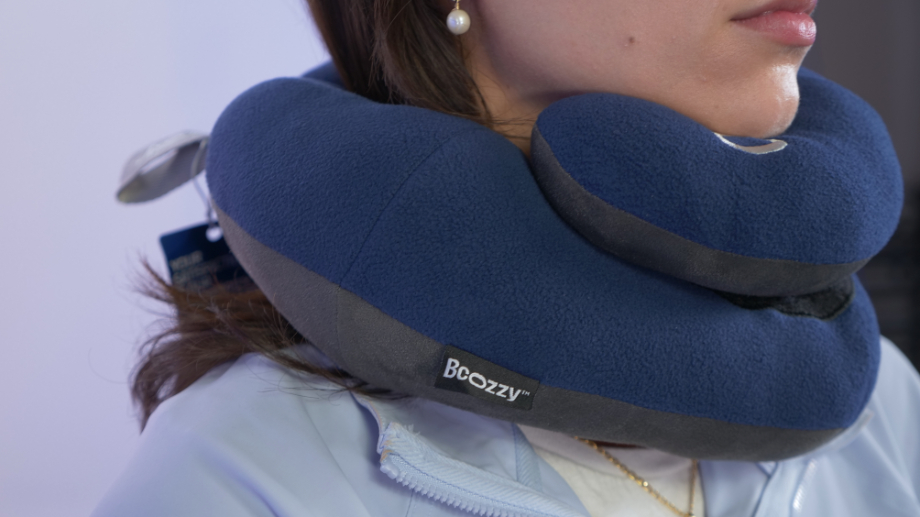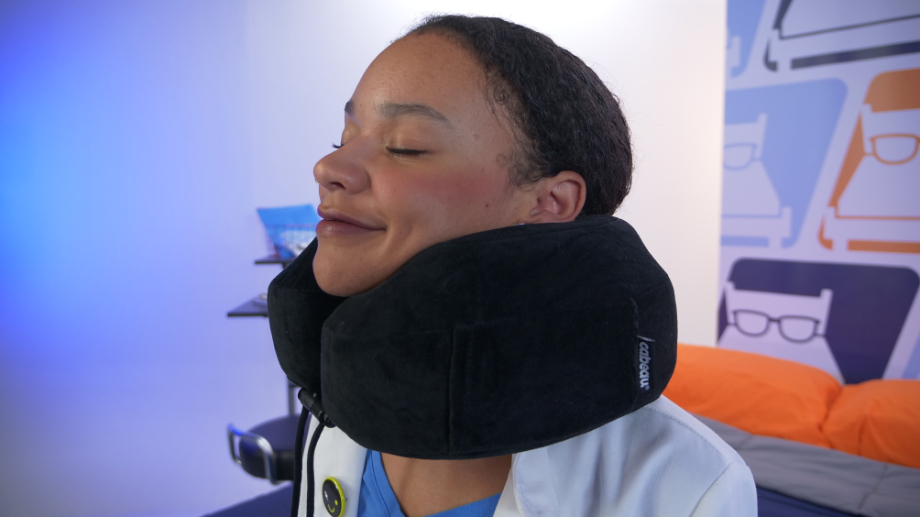Best Travel Pillows
Disclosure: By clicking on the product links in this article, Mattress Nerd may receive a commission fee at no cost to you, the reader. Read full disclosure statement.

Written by Becca Fair, Certified Sleep Science Coach
Methodology
Here at Mattress Nerd, we’ve tested hundreds of sleep products to bring you unbiased, expert reviews of the top brands.
In This Article
We’ll tell you about the best pillows for staying comfortable on the go, be it in a plane, train, or car.
No matter how often you’ve hopped on an airplane, driven cross-country, or stayed in a hotel, even the most experienced travelers can experience hiccups along their journey. While taking the upsets in stride can result in a happier experience overall, staying comfortable on the way to and from your destination is something you can control—or at least try to.
Gone are the days of sleepless travel. Adding a compact, cozy pillow to your journey can make a big difference in taking the stress out of your travel experience. In this guide, we’re rounding up our picks for the best travel pillows of 2024, based on our own testing, and sharing tips on what to look for when shopping for a travel pillow, why you should use one, plus some advice for sleeping on the go. Save time and money, and choose a supportive and comfortable option from our expert-vetted list!
Bottom Line: What’s the Best Travel Pillow?
Our Editor’s Pick for the best travel pillow, the Trtl Travel Pillow, is a super-soft pillow wrap designed to help travelers snooze comfortably with complete head support.
Best Travel Pillows
- Trtl Travel Pillow – Nerd’s Pick
- J-Pillow Travel Pillow – Best Alternative Design Travel Pillow
- TravelRest Curl Memory Foam Pillow – Best Non-Inflatable Travel Pillow
- AirComfy Travel Pillow – Best Inflatable Travel Pillow
- Bcozzy Pillow – Best Travel Pillow for Headphones
- Cabeau Evolution Classic Travel Pillow – Best Travel Pillow Available at Airports
Video Roundup

Nerd’s Pick: Trtl Travel Pillow
trtl Pillow

Looking for a self-supporting neck pillow? The trtl is an affordable, wrap around neck support that doesn’t require cuddling up to a window or seat for stability. It may look similar to a neck brace, but it definitely comes in handy if you’re stuck with the aisle or middle seat while traveling.
Accessories Details
Material
Polyester
Financing
Not Available
Shipping Method
Free shipping
Return Policy
Free returns
At half the size of a traditional travel pillow, the ergonomic Trtl pillow switches up typical travel comfort. It has an inner rib that contours to your shoulders, neck, and jawline for scientifically-proven head and neck support. It’s made from fleece for a soft to the touch feel that’s particularly nice on cold planes. The hook-and-loop fastening means you can position comfortably against your neck, while the internal support system hidden in the soft fleece has a hammock effect that makes it easy, and even comfortable, to fall asleep while in an airplane or car seat. Plus, the Trtl is machine washable.
Reason to Buy: U-shaped neck pillows don’t provide some travelers with the support they need— especially if they commonly fall asleep with their heads tilted forward. Trtl created this fleece pillow to address that exact issue. It’s our pick for travelers who tend to stay on one side while sleeping, or again, need that support under their chin to prevent neck strain. It’s tiny, packable, and the fleece will help keep you warm on cold airplanes.
Pros of the Trtl Travel Pillow
- Small size takes up less space
- Ergonomic design for superior neck and head support
- Versatile style can be used around the neck or behind the head as a more traditional pillow
Cons of the Trtl Travel Pillow
- Fleece may be too warm in some climates
- May not be sized to fit comfortably on all necks
Best Alternative Design Travel Pillow: J-Pillow Travel Pillow
J-Pillow Travel Pillow

This unique travel pillow is shaped to support your head, neck, and chin. However, it’s important to note, you need to have a surface to lie against, like the window of a plane or car, in order to keep the pillow in place.
Mattress Nerd Score
4.30 / 5
Accessories Details
Material
Memory foam
Trial Period
60 nights
Warranty
6-month warranty
Financing
Not Available
Shipping Method
Free shipping
Return Policy
Free returns
Just as the name implies, this travel pillow is literally shaped like the letter “J”, and designed to cradle your head, neck, and chin. This unique shape works to will keep your head comfortably upright and prevent it from rolling too far to the side or nodding forward. The three-way support system makes it easy to sleep on almost any mode of transportation. Plus, it’s easily compressible, has a snap-loop fastener to attach to luggage, and feels soft to the touch. It’s available in a choice of three colors, comes with its own travel bag, and can be machine washed for easy cleaning.
Reason to Buy: Originally designed by a flight attendant familiar with the challenges of sleeping during travel, the unique shape fills the awkward gap between your head and shoulders for more comfort and conformity. The pillow can be twisted into many positions and works well for cars, camping, bus rides, and airplanes.
Pros of the J-Pillow Travel Pillow
- Compresses easily
- Includes travel bag that attaches to luggage
- Three-way support system cradles the neck, head, and chin
Cons of the J-Pillow Travel Pillow
- One size may not work for everyone
- May be too soft to ensure sufficient support for some people
- May be difficult to use if you don’t have a window seat, aisle seat, or head rest for additional support
Best Non-Inflatable Travel Pillow: TravelRest Curl Memory Foam Pillow
Travelrest

The Travelrest is your typical, memory foam u-shape travel pillow. If you’re looking for a quick and easy option for your trip, this is your best bet.
Mattress Nerd Score
4.40 / 5
Accessories Details
Material
Memory foam
Trial Period
30 days
Financing
Not Available
Shipping Method
Free shipping
Return Policy
Free returns
This soft yet highly supportive travel pillow has a memory foam interior and a microfiber cover. While made in a traditional “U” travel pillow shape, the TravelRest goes one step further with an adjustable drawstring that provides a customized fit. Memory foam responds to heat and pressure to contour to the curve of your neck, head, and shoulders, so you can expect maximum support with this travel pillow. It’s also convenient to carry, since the elastic drawstring can be easily attached to telescoping luggage handles. The TravelRest travel pillow also comes in a choice of two colors.
Reason to Buy: This looks similar to other non-inflatable models out there, but the difference is in the details. This pillow’s shape recovers with every use and conforms closely to the neck and shoulder areas. The microfiber cover is removable and machine washable, and the pillow is protected by a two-year warranty. Very few travel pillows come with this level of warranty coverage, if at all.
Pros of the TravelRest Curl Memory Foam Pillow
- Memory foam offers maximum support
- Adjustable drawstring for customized fit
- Machine washable cover
Cons of the TravelRest Curl Memory Foam Pillow
- One size may not work for everyone, even with the drawstring
- Memory foam can become uncomfortably warm
- May not attach to all types of luggage
Best Inflatable Travel Pillow: AirComfy Travel Pillow
AirComfy Inflatable Travel Pillow

Compact and convenient, the AirComfy is an inflatable travel pillow that eliminates the annoyance of a bulky full size option.
Mattress Nerd Score
4.40 / 5
Accessories Details
Financing
Not Available
This inflatable pillow forms into an hourglass shape when inflated and has a built-in elastic headrest attachment to keep it firmly in place. The versatile design works well for airplane and auto travel, but you can also use it on your back, knees, and other areas that might experience tension or aching when you’re seated for long periods of time. The AirComfy is also adjustable to suit different preferences for comfort and support, and the foam interior eliminates the bouncy feel common to inflatable pillows. At just half a pound, it’s also ultra lightweight and easy to tote around during travel.
Reason to Buy: Inflatable travel pillows are an excellent choice for travelers who want to save as much space as possible. The AirComfy design is affordable, comes with a travel-ready carrying case, and inflation is easy because the pillow is so compact. Keep in mind that this pillow doesn’t come with a removable cover, but it can be easily spot cleaned.
Pros of the Aircomfy Travel Pillow
- Lightweight and easy to tote around
- Versatile design means it can be used in different ways
- Can be customized for individual support and comfort
Cons of the Aircomfy Travel Pillow
- Doesn’t cradle the head and neck as some other designs do
Best Travel Pillow for Headphones: Bcozzy Pillow
BCOZZY Neck Pillow

The BCozzy travel pillow provides head, neck, and chin support by wrapping lightly around your neck for full range support. It also comes in a range of sizes to accommodate travelers of all ages and weights.
Mattress Nerd Score
4.30 / 5
Accessories Details
Material
Polyester
Financing
Not Available
Shipping Method
Free shipping
Return Policy
Free returns
The lightweight Bcozzy comes in an adjustable design that features overlapping ends so that the travel pillow holds your chin in place. The flexible shape supports your head from side to side and front to back, depending on how you position it. Plus, it’s a nice balance of firm and soft—the breathable fabric cover is made of micro fleece and microsuede, with a down alternative fill. While not as compressible as other models, it does have a small loop that can be attached to your luggage. And bonus—the entire pillow can be popped in the machine for easy washing.
Reason to Buy: Travelers who use large headphones that fit over-the-ear will find that these fit snuggly with most pairs, holding your chin in place via the overlapping design and leaving space on either side of the neck for headphones. It is available in several colors and sizes.
Pros of the Bcozzy Pillow
- Pairs well with headphones
- Versatile design
- Entirely machine washable
Cons of the Bcozzy Pillow
- Doesn’t compress as well as other models
- May not stay in place well enough for sufficient support
Best Travel Pillow Available at Airports: Cabeau Evolution Classic Travel Pillow
Cabeau Evolution Classic Neck Pillow

The Cabeau Evolution Classic Neck pillow comes in the traditional u-shape design for head and neck support. Its robust profile allows for full support, which is great for those with existing neck pain.
Mattress Nerd Score
4.80 / 5
Accessories Details
Material
Memory foam, Cotton
Warranty
1-year limited manufacturer’s warranty
Financing
Available
Shipping Method
Free shipping minus HI and AK
This memory foam pillow has the traditional u-shape design of many travel pillows. But it also includes an adjustable string closure, and the design as a whole works well for small people in particular. It’s a popular buy because of its ubiquity—it can be found in airport stores around the country. The Cabeau is a one-size-fits-all travel pillow with a removable and washable cover, which is a nice bonus. It’s designed to wrap around the neck to provide head support, with a front clasp to keep it securely in place. It’s also available in three colors.
Reason to Buy: The Cabeau is widely available at airport stores nationwide, so if your flight gets delayed or you forget your travel pillow at home, this would be our recommendation. While not the most comfortable travel pillow out there, as the back isn’t contoured, it’s a reliable option you’ll find beyond security checkpoints.
Pros of the Cabeau Evolution Classic Travel Pillow
- Can be purchased at airports nationwide
- Works well for smaller people
Cons of the Cabeau Evolution Classic Travel Pillow
- Lacks contouring in the back
- Memory foam can get uncomfortably warm
- Only available in one size
Why Use a Travel Pillow
Nothing beats sleeping at home in your own bed, but a travel pillow can provide comfort and support when you’re sleeping on the go. They’re most commonly used in cars and on airplanes, but frequent travelers keep them on hand for trains, buses, other forms of public transportation, and even campsites.
Most adults know that sleep is essential to health, and when you’re faced with a red-eye flight, a cross-country road trip, or overseas travel, your ability to rest is seriously impacted. Most seats, whether on airplanes or in vehicles, don’t recline fully and are cramped, making sleeping difficult. Combining your seating situation with the realities of jet lag, time changes, and dehydration is a recipe for losing sleep, getting sick, and arriving at your destination in less-than-stellar health.
Whether you opt for a simple, affordable u-shaped travel pillow or a pricier version with special features, having a travel pillow on hand can make the difference between serious discomfort and a night’s sleep you can function relatively well on.
Types of Travel Pillows
Today, travel pillows come in all shapes and sizes. With all the choices out there, it’s important to understand the options so that you find the right pillow to accommodate your travel and comfort needs.
Shapes
U-shaped travel pillows are the most well-known, and they’re the kind you’re most likely to see in airports and brick-and-mortar stores. The simple design wraps around your neck, often with an adjustable drawstring or buckle closure. However, some individuals find that U-shaped pillows don’t provide enough neck support, depending on the loft.
J-shaped travel pillows are less common and new to the market, and they provide better chin support by propping the chin up. Hourglass travel pillows are the most versatile shape as they can be used for your neck, back, knees, and legs. Rectangular travel pillows are also available, and they look similar to a pillow you’d use in your bed at home. If your neck supports itself well while sleeping, a rectangular travel pillow could work for you. Infinity pillows, which are designed to be looped in multiple ways, are another option.
Inflatable vs. Non-Inflatable Travel Pillows
Whether inflatable or non-inflatable travel pillows are more effective is up in the air. The best travel pillow for you will depend on your preferences and a few other factors, like space and loft needs.
Non-inflatable pillows tend to be made with memory foam, though latex and other materials have crept their way into the market. Many argue that memory foam and other hard materials are more comfortable to lay on than the air that fills inflatable travel pillows.
The tradeoff, however, is size and portability. Inflatable pillows can be rolled, folded, and easily slipped into a carry-on bag, purse, or even your pocket. Non-inflatable pillows take up more space, but they are more widely available in need-specific designs and shapes, like j-shapes, infinity loops, and hourglass shapes.
Considerations for Travel Pillows
If you’re reading this guide, we doubt you’re the type to realize you’ll be sleeping on a flight and grab a travel pillow at the closest airport shop. The travel pillow market is expanding and diversifying, so here’s a brief list of considerations to take into account when you’re looking for the best travel pillow this year.
- Sleeping Position: Pressure points tend to make themselves known when we sleep in an upright position, so understanding how your neck, head, and shoulders react when you’re attempting to sleep without reclining fully is key. Your neck will naturally tilt forward as you drift off. Find a pillow that allows you to lean your head and neck back further to avoid this risk when you fall asleep.
- Loft: Just like normal pillows, travel pillows vary in the loft. Some sleepers require more inches of loft to feel supported, as the higher loft allows you to keep your neck upright. An inflatable pillow is advantageous if you like to adjust the pillow loft or if the travel pillow will be used by multiple sleepers.
- Price: Travel pillows tend to range from $10 to $50, with inflatable travel pillows coming in on the lower side of that spectrum.
- Shape: With square, u-shaped, j-shaped, rectangle, hourglass, and more models available, you’ll have options with regard to shape. Most travelers will be satisfied with a classic u-shaped travel pillow, but if you want to explore other shapes, here’s what to take into consideration. If you sleep on your side, you may not do well with a u-shaped, which works best for those who lean their heads directly back to rest. If you travel frequently by train or car or have aches in your knees, legs, and lower back, hourglass or j-shaped pillows, which are adjustable and can work for different areas of the body, could work well.
Tips for Sleeping While Traveling
Keeping sleep disruption to a minimum when traveling can make the difference between an enjoyable time at your destination and a cranky, sleep-deprived one. Our bodies have an optimal sleep window, called the circadian window, and travel can wreak havoc on it. Here’s how to sleep while you travel:
- Prepare for travel by moving your bedtime slightly earlier than normal. Planning ahead can help adjust the transition into a new time zone and make it easier to sleep with your travel pillow on the go
- Adjust your sleep schedule as soon as you begin to travel. For example, if you’re flying to Europe from the United States, try not to drift off if you know it’s morning at the destination. If you happen to be traveling when it’s the middle of the night at your destination, then you should try to catch some zzzs.
- Consider melatonin and magnesium supplements, which can aid in the body’s natural production of melatonin to help lull you off to sleep. Melatonin is available in non-prescription sleep aid doses of up to 10 milligrams. Just be sure to shop from reputable brands.
- Choose your airplane and car seat wisely. Try to get a window seat on the plane or in the car, if possible, so that you can lean on the edge and won’t be disturbed by other travelers waking to use the restroom or move about. You’ll also have control over the window shade.
- Try calming music to relax if you have a streaming subscription of Apple Music. Pre-made sleep playlists are readily available, with instrumental piano, harp, and other calming sounds to help you reach REM sleep.
FAQs about the Best Travel Pillows
Are airplane travel pillows worth it?
Airplane travel pillows can be a great idea, even if you’re not planning on sleeping. A good travel pillow gives you a little support when you’re stuck in that upright position, which can keep aches and pains and even headaches at bay. Plus, they come in various configurations and materials to suit different needs and preferences.
What type of neck pillow is best for travel?
Personal preference will ultimately be the deciding factor, but it’s a good idea to look for a travel pillow that can be adjusted to meet individual needs. The goal is a pillow that supports you comfortably without creating aches and pains. Perks like carrying bags, hooks or snaps that make it easy to snap onto your luggage when the pillow isn’t in use, and removable, washable covers are also worth prioritizing.
Should a travel pillow be hard or soft?
The goal of a travel pillow is to make you comfortable, so a balance of firmness and softness is ideal. You need sufficient support, so you don’t want a pillow that’s too soft. On the other hand, a pillow that’s too firm can push your head and neck out of alignment. Medium-firm is generally a safe bet. Look for a pillow with some level of adjustability as well, so you can customize the feel.
Conclusion
Sleeping while traveling can be tough. Your routine is disrupted, the distractions are endless, and your body’s clock is usually thrown for a loop. If a travel pillow can, even in a small way, make your journey more comfortable and restful, it’s worth the investment.
After testing, we believe the Trtl pillow is the best travel pillow because of its 360 support, and the fact it’s not contingent on having a window seat for additional aid. It’s also budget-friendly, compact and works with any sleeping style. Try it out and you’ll be well on your way to a more pleasant travel experience, wherever you’re headed. Safe travels!

